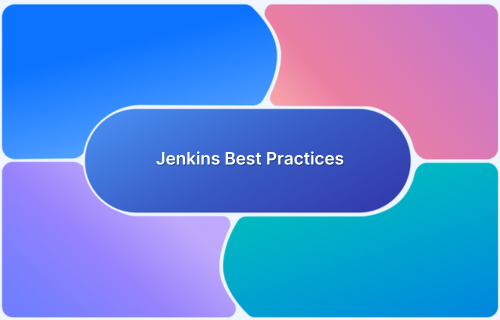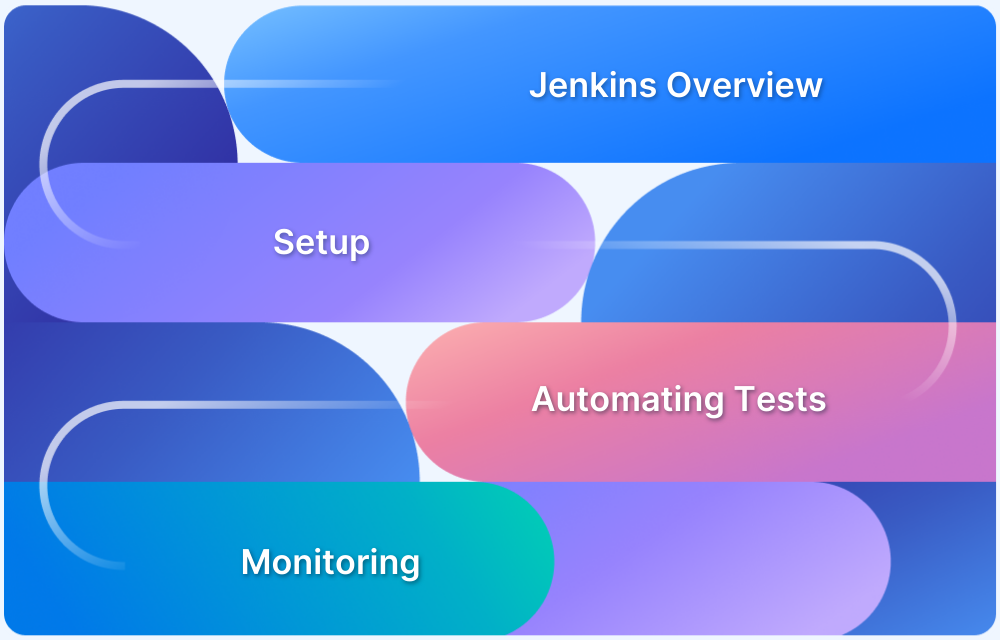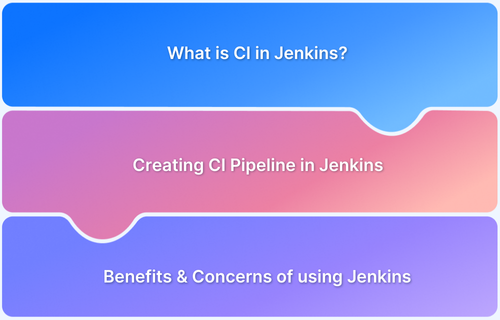Jenkins is a popular CI/CD automation server with nearly 1.6 million customers worldwide. It is open source and supports a wide range of languages and repositories using pipelines. It seamlessly integrates your builds, tests, and deployment tools.
A lot of developers use Jenkins for DevOps. Hence, it is essential to know the best practices and follow them to make the most out of them.
Why use Jenkins?
Jenkins streamlines the development workflow by automating repetitive tasks like building code, running tests, and deploying applications.
Key benefits of Jenkins include:
- Faster development cycles through automated builds and tests
- Early bug detection with continuous integration
- Customizable pipelines to fit any project or tech stack
- Strong ecosystem of plugins for seamless integration
- Support for distributed builds, improving scalability and performance
Also Read: CICD with Jenkins
Jenkins Best Practices
Jenkins is used to continuously develop and install your software projects, making it more straightforward for developers to incorporate design changes and for users to get a new build. Jenkins software’s ability to track recurring tasks while a project is being developed is what made it so famous.
Here are the key best practices of using Jenkins:
- Secure Jenkins
- Always create a backup of the Jenkins Home Directory
- Create a Unique Job or Project for each Newly Created Maintenance or Development Branch
- Avoid Resource Collisions when Running Parallel Jobs
- To Manage Dependencies, use “File Finger-printing”
- Avoid Complicated Groovy Code in Pipelines
- Avoid Direct Jenkins Internal API Calls
- Create a Scalable Jenkins Pipeline
- Maintain higher Code Coverage and perform System Testing as part of the Pipeline
- Use Declarative Pipelines for Clarity and Consistency
- Speed Up Pipelines with Parallel Testing
- Distribute Workloads with Jenkins Agents
- Avoid Scheduling Overload in Jenkins
- Use Environment Variables for Configurable Pipelines
- Archive Artifacts for Easy Retrieval
- Set Build Retention Policies to Manage Disk Space
- Perform Security Scans in the Pipeline
- Use input Step Wisely
- Ensuring No Builds Run on the Master Node
- Leveraging Docker Integration for Consistent and Isolated Build Environments in Pipelines
- Ensuring Pipeline Resilience
- Adopting Consistent Project Naming Conventions
- Optimizing Job Scheduling to Avoid Controller Overload
- Enhancing SCM Integration
For instance, if the team is working on projects, Jenkins ensures your project updates and updates if there are any mistakes at the beginning of the process. To make the best out of it, here are some of the best practices of Jenkins every developer must know and follow:
1. Secure Jenkins
Securing Jenkins involves configuring robust authentication, authorization, and protection mechanisms to safeguard your CI/CD environment.
- Configure Auth Mechanisms: Use Jenkins’ user database or LDAP for authentication; enable Matrix-based authorization for fine-grained access control.
- Enable CSRF Protection: Prevent unauthorized actions by ensuring CSRF protection is active in global security settings.
- Manage Script Approvals: Review and approve Groovy scripts via the In-process Script Approval screen to block untrusted code.
2. Always create a backup of the Jenkins Home Directory
Jenkins’ home directory includes a large amount of data, such as job setups, build logs, plugin configurations, and so on, which we can afford to lose. This may be performed via Jenkins plugins or by creating a process to take backups. It’s one of Jenkins’ most important best practices.
How to implement it?
- Backup Plugin: Using the plugin is NOT advised because, for the backup of your data, you must manually start it.
- Jenkins has halted any improvements to it because better options are available.
- Thin Backup Plugin: One of the most useful plugins provides scheduled periodic backups.
- Manage Jenkins -> Manage Plugins -> Install the plugin. Click the ‘Available’ tab and search for ‘Thin Backup.’
- After installation, navigate to Manage Jenkins -> ThinBackup -> Settings.
- Configuration options for the plugin are self-explanatory, and for any ambiguity, ‘?’ beside every setting is a boon!
- To test the backup, click ‘Backup now.’
- Periodic Backup Plugin: This is a substitute to the existing ‘Backup Plugin,’ which will run regularly once configured.
The plugin specifies three extension points:
- File Manager: It specifies which files should be backed up and the rules for restoring those files. Confidently, for instance, it will only select configuration XML files.
- Storage: It describes how backups are archived and unarchived. For instance, “ZipStorage” will zip up backup data after compression.
- Location: It specifies the localization of the backups by location. For instance, “LocalDirectory” will place the backup files in the designated directory.
Establish a regular backup job.
- When building a new Jenkins job, select “Freestyle project.”
- Select “None” for SCM.
- In Build Triggers, choose “Build periodically,” and in Schedule, set the frequency. Giving “H 12 * * *,” for instance, will back up each day at 12.25.30 GMT.
- Add a build step called Execute Shell to use this file as the build job and command.
Jenkins configuration backups are stored in Google Cloud.
This works best if you have a Google Cloud Kubernetes cluster with a Jenkins web server deployed over it. Connect to the cloud via installing the Cloud Storage plugin and using the “Thin Backup plugin”. The recommended Jenkins security best practice is the use of Thin Plugin in connection with either setting up a pipeline or configuring a task.
3. Create a Unique Job or Project for each Newly Created Maintenance or Development Branch
You can encourage future parallel development and optimize the benefit of probing bugs by setting various jobs/projects for each branch, which lowers risk and boosts developer productivity.
How to implement it?
The program divides tests into various, nearly equal-sized units based on the previous test execution time. The exclusion list is then created for each component.
Any testing job that requires the use of this tool
- Create XML files that are JUnit compliant.
- Accept a file containing a test-exclusion list.
You are responsible for setting up the build process to respect the exclusion file.
4. Avoid Resource Collisions when Running Parallel Jobs
You must prevent collisions between concurrent jobs that could damage your Jenkins pipeline if they require exclusive access to a service or establish one. Giving access to resources simultaneously might cause deadlock situations, and the system might crash. Hence, DevOps experts strongly advise using it as one of the CI/CD best practices.
How to implement it?
Build conflicts are avoided by allocating separate ports for concurrent Project runs. Throttle Parallel Builds Plugin is an excellent example of a persistent resource like a database that needs to be locked.
5. To Manage Dependencies, use “File Finger-printing”
Keeping track of which version is used and which version might be complicated when establishing interdependent projects on Jenkins. To simplify this, make the most of “file fingerprinting,” which Jenkins supports.
How to implement it?
The configuration of all pertinent projects must be set to record all biometrics of the following:
- Jar files generated by your project.
- Jar files that are necessary for your project.
Go to your project to create a job to capture fingerprints. For clarity, you can take note of fingerprints.
6. Avoid Complicated Groovy Code in Pipelines
Minimize complex Groovy logic to keep your Jenkins pipelines lightweight. Avoid using JsonSlurper or XmlSlurper or making heavy external calls in the controller.
Instead:
- Use sh/bat steps on agents to handle parsing with tools like jq.
- Run HTTP requests using curl or wget on the agent and return only essential data.
Learn More: Jenkins for Test Automation
7. Avoid Direct Jenkins Internal API Calls
Avoid using internal Jenkins APIs like Jenkins.getInstance() in Pipelines or shared libraries. These unstable calls may break across Jenkins versions and pose security risks.
Instead, complex logic can be moved into shared libraries and interpreted with Jenkins through supported, stable interfaces.
8. Create a Scalable Jenkins Pipeline
Shared Libraries are the apex of adoption. Compared to a standard programming library, shared libraries provide version-controlled Pipeline code, which can be saved and used via any Source Control Management (SCM).
How to implement it?
You’ll require a source file having a consistent structure kept in your SCM, and then you’ll link the library to your Jenkins instance using your SCM’s plugin and:
- Enable Global Shared Libraries by going to Manage Jenkins -> Configure System -> Global Pipeline Libraries or
- At the folder level, by controlling that particular folder.
- Using the library name as ‘@Library‘ within the Jenkins file will enable a pipeline to use that shared library.
9. Maintain higher Code Coverage and perform System Testing as part of the Pipeline
By lowering UAT and product problems, maintaining 90% code coverage ensures a higher ROI. While better coverage alone cannot ensure code quality, displaying code coverage and data can assist your programmers, and QA avoids defects early in the development cycle.
Read More: Calculating Test Automation ROI: A Guide
How to implement it?
1. The Jenkins Cobertura plugin lets you download Cobertura’s code coverage reports.
Configuring the Cobertura Plugin:
- Cobertura can be installed by learning to Handle Jenkins -> Manage Plugins.
- Set up the build script for your project to produce Cobertura XML reports.
- Activate the publisher for “Publish Cobertura Coverage Report.”
- Indicate the location of the folder where the coverage.xml reports are produced.
- Set the coverage measurement targets to correspond with your objectives.
2. Keep track of code coverage. Most of the repetitive work for other plugins, such as Cobertura, is handled by an API plugin, a single API plugin.
The critical functions of this API plugin are:
- Locating coverage reports based on user preferences.
- To transform reports into a standard format, use adapters.
- Assemble reports in a standard format that has been digested, then display the results in a chart.
Therefore, providing code coverage requires the creation of an adapter that does one thing, namely, convert coverage reports into a standardized way.
Must Read: Code Coverage Techniques and Tools
10. Use Declarative Pipelines for Clarity and Consistency
Declarative pipelines enforce a structured, standardized syntax that is easier to read, maintain, and debug. This reduces complexity and errors, especially in teams where developers have varying levels of Jenkins experience.
How to implement it?
- Define your Jenkinsfile using declarative syntax with clearly structured pipeline {} blocks.
- This organizes your pipeline into stages like Build, Test, and Deploy, making it easy to follow.
- Example:
pipeline {
agent any
stages {
stage('Build') {
steps {
echo 'Building...'
}
}
}
}11. Speed Up Pipelines with Parallel Testing
Running tests in parallel reduces build time, providing faster feedback to developers. This improves efficiency, especially in large projects with extensive test suites.
How to implement it?
- Define parallel stages in your Jenkinsfile:
stage('Parallel Tests') {
parallel {
stage('Unit Tests') {
steps {
echo 'Running Unit Tests...'
}
}
stage('Integration Tests') {
steps {
echo 'Running Integration Tests...'
}
}
}
}- This allows multiple tests to run concurrently, reducing overall pipeline time.
12. Distribute Workloads with Jenkins Agents
Running all jobs on a single master can cause bottlenecks as your project scales. Distributing jobs across multiple agents helps Jenkins handle larger workloads and allows specialization (e.g., running specific tests on different platforms).
How to implement it?
- Configure agents in Manage Jenkins -> Manage Nodes.
- Assign labels to each agent (e.g., linux, windows) and specify which jobs should run on them using the agent directive in the Jenkinsfile:
stage('Build') {
agent { label 'linux' }
steps {
echo 'Building on Linux agent...'
}
}13.Avoid Scheduling Overload in Jenkins
Overloading Jenkins with concurrent jobs can cause resource contention, slower builds, and system performance issues. Distributing job start times prevents bottlenecks and ensures smoother execution.
How to Implement it?
- Use H in Cron Expressions:nIntroduce jitter with H to stagger job start times, avoiding simultaneous job execution.
H * * * * // Runs the job at a random minute every hour - Use cron tokens like @hourly to automatically distribute jobs evenly.
- Use Throttle Concurrent Builds Plugin to limit the number of jobs running simultaneously and prevent overload.
- Install the Monitoring Plugin to track resource utilization and adjust schedules as needed.
14. Use Environment Variables for Configurable Pipelines
Hardcoding values like API keys or deployment URLs can make pipelines less flexible and harder to maintain. Environment variables allow you to externalize these values, making your pipeline adaptable to different environments (development, staging, production).
How to implement it?
- Define environment variables in the Jenkinsfile:
environment {
ENV_NAME = 'production'
API_KEY = credentials('api-key-id')
}- This keeps your pipeline dynamic and easier to manage across environments.
15. Archive Artifacts for Easy Retrieval
Storing important build artifacts such as binaries, logs, and reports helps with debugging, audits, and future releases. Jenkins allows you to archive these artifacts for easy retrieval.
How to implement it?
- Use the archiveArtifacts step in your pipeline to store artifacts after a successful build:
steps {
archiveArtifacts artifacts: '**/target/*.jar', allowEmptyArchive: false
}- This keeps a record of each build’s output for future use.
16. Set Build Retention Policies to Manage Disk Space
As Jenkins builds accumulate, they can take up a lot of disk space. Setting retention policies helps you discard old, unnecessary builds, preventing Jenkins from slowing down.
How to implement it?
- In each job’s configuration, enable Discard Old Builds and specify the number of builds or the age of builds to keep.
- This helps ensure that Jenkins only retains relevant builds, reducing storage overhead.
17. Perform Security Scans in the Pipeline
Incorporating security checks into your pipeline can catch vulnerabilities early, ensuring safer code before it reaches production. Automated security scans minimize the risk of vulnerabilities being introduced into the codebase.
How to implement it?
- Integrate security tools like SonarQube or OWASP Dependency Check into your pipeline:
stage('Security Scan') {
steps {
sh 'sonar-scanner'
}
}- These tools can automatically scan code for vulnerabilities and quality issues during the build process.
18. Use input Step Wisely
When using the input step in a Pipeline to pause for manual approval, ensure it is placed outside any agent block (or node block in Scripted Pipeline).
An input step within an agent block will hold onto the allocated agent and its executor while waiting, tying up valuable resources. Placing it outside allows the agent to be freed during the pause.
19. Ensuring No Builds Run on the Master Node
Prevent builds from running directly on the Jenkins controller (master node). The controller should be reserved for orchestration tasks.
Configure the controller with zero executors, forcing all build activities onto dedicated agent nodes. This enhances security by protecting JENKINS_HOME and improves scalability and stability by not consuming controller resources with build processes.
20. Leveraging Docker Integration for Consistent and Isolated Build Environments in Pipelines
Integrate Docker into your Jenkins Pipelines to create consistent, reproducible, and isolated build environments.
Define your build tools and dependencies within a Dockerfile, and have your Pipeline use docker.image(‘my-image’).inside {… } (or similar agent configurations) to run build steps within containers spun from that image.
This eliminates “works on my machine” issues and simplifies agent management.
21. Ensuring Pipeline Resilience
Jenkins Pipelines are designed to be resumable after a controller restart, which requires their state to be serialized.
If your Pipeline script uses objects in variables that are not serializable (i.e., cannot be converted to a byte stream), a NotSerializableException can occur, typically when Jenkins tries to persist the state or upon restart.
While the provided materials do not detail specific handling techniques for this exception, be mindful of storing only serializable objects in variables that need to persist across resumable steps.
22. Adopting Consistent Project Naming Conventions
Use simple and consistent naming conventions for your Jenkins jobs and projects.
It’s recommended to limit names to alphanumeric characters, underscores, and hyphens (a-z, A-Z, 0-9, _, -) to avoid issues with file paths or tools that may not handle spaces or special characters well.
Jenkins’ “Display Name” feature can make names more user-friendly in the UI while keeping the underlying project ID compliant and straightforward.
23. Optimizing Job Scheduling to Prevent Controller Overload
When scheduling jobs using cron expressions (e.g., for nightly builds or regular polling), distribute their start times to avoid overloading the Jenkins controller with many jobs starting simultaneously.
Jenkins cron syntax supports a special H (for “hash”) symbol instead of numeric values.
Using H (e.g., H H * * * for a daily build at a random time) allows Jenkins to automatically spread out the load based on the job name, rather than having all jobs with similar schedules trigger at the exact same minute or hour.
24. Enhancing SCM Integration
Deepen the integration between Jenkins and your Source Code Management (SCM) system. Configure Jenkins to link build information to your SCM, such as updating commit statuses or pull requests.
While direct integration with issue trackers or automated SCM tagging upon successful builds isn’t explicitly detailed as a setup step in the provided snippets, these are valuable practices.
Many SCM hosting platforms and issue trackers offer webhooks or APIs that can be leveraged, and Jenkins plugins often facilitate sending build status information to SCM platforms.
Integrate BrowserStack QEI for Complete Visibility Into Test Quality
As Jenkins pipelines scale, tracking test quality across stages, environments, and tools becomes challenging.
BrowserStack’s Quality Engineering Intelligence (QEI) offers a centralized dashboard that gives teams a real-time view of their entire testing ecosystem.
BrowserStack’s QEI aggregates data from Jenkins, test frameworks, management tools, and issue trackers to surface insights around coverage, defect trends, automation stability, and release velocity, eliminating the need for manual reporting.
Benefits of integrating QEI into your Jenkins pipeline:
- Comprehensive visibility into all test activities
- Early detection of flaky tests and unstable environments
- Accurate measurement of automation impact and test ROI
- Reliable insights for data-driven release decisions
- Custom dashboards tailored to project or team needs
Conclusion
Jenkins is a powerful open-source automation tool for building CI/CD pipelines. It integrates seamlessly with various tools and environments to streamline development, testing, and deployment.
To maximize Jenkins, follow key best practices: enforce proper security configurations, manage permissions effectively, automate backups, and maintain clear, descriptive pipelines. Avoid overly complex Groovy scripts; use shared libraries and structured Jenkins files instead.
Finally, prioritize code coverage and quality metrics within your pipeline. Strong test coverage ensures reliability and is central to delivering robust, production-ready software.






